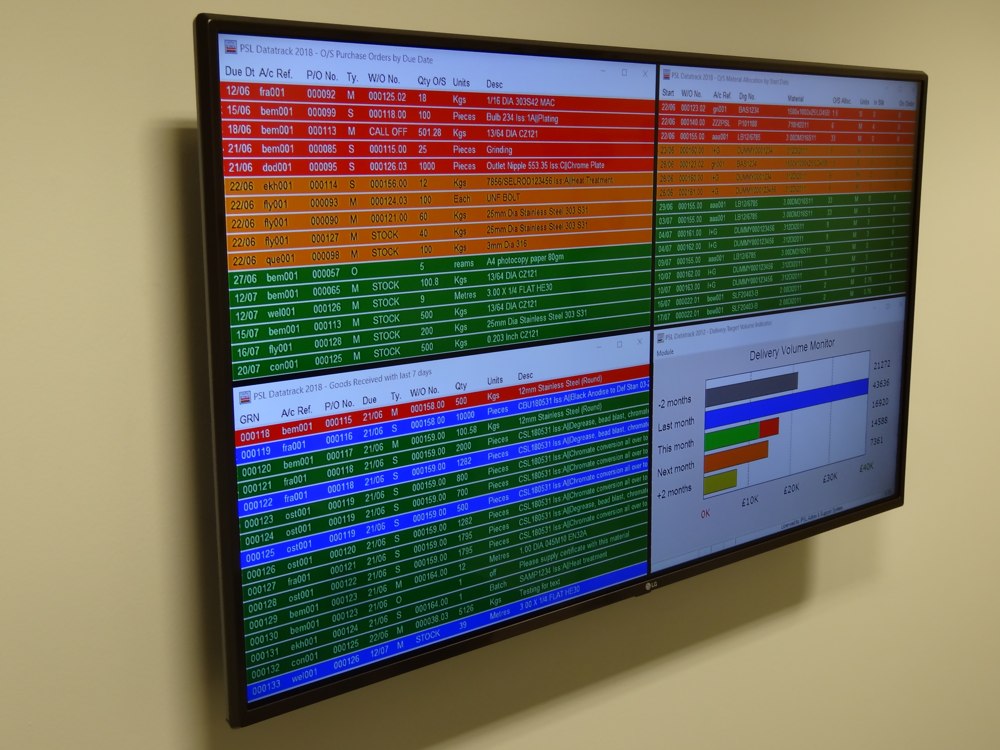Taking control with smarter software

Aerospace manufacturers are increasingly utilising the power of software, such as Material Requirement Planning and Enterprise Resource Planning to manage and integrate all facets of their business. Ed Hill speaks to three leading developers of this software.
Aerospace manufacturers are increasingly utilising the power of software, such as Material Requirement Planning and Enterprise Resource Planning to manage and integrate all facets of their business. Ed Hill speaks to three leading developers of this software.
There’s no doubt that we live in a data-driven age, particularly in the manufacturing industry. So many elements of these businesses are reliant on computing and software, whether it be for designing and manufacturing components to admin tasks, such as invoicing or the payroll.
When it comes to manufacturing parts and production control, the roots of modern-day Material Requirement Planning (MRP), Manufacturing resource planning (MRP II) and its more all-encompassing derivative Enterprise Resource Planning (ERP) software can be traced back to the 1960s. With the development of the PC, these systems became not just the domain of large OEMs and primes, but most SMEs in the supply chain.
Three leading developers of these kinds of systems and further advanced forms of integrated manufacturing software are PSL Datatrack, Valuechain and Javelin/Workplan (now part of Hexagon Manufacturing Intelligence). All three argue that in aerospace manufacturing particularly, these types of systems offer businesses huge benefits.

“ERP systems provide the opportunity to have a single source of truth for your business,” asserts Jo Bradley, software consultant at Hexagon Manufacturing Intelligence ERP Division. “They provide joined-up data leading to total visibility, increased efficiency, improved reporting and business information. ERP systems contain and manage areas including planning, scheduling, resource loading, costing, profit, forecasting, quotes and estimates. MRP systems assist in balancing supply and demand. Providing information to drive key business decisions. Help in understanding resource loading. Profit – planned versus actual costs and monitoring quality and costs to the business. This information is key in understanding where improvements can be made.”
Geoff Gartland, managing director of PSL Datatrack outlines how advantageous these systems can be over more traditional paper practices.
“The management of contracts and work schedules doesn’t need to be paper-based anymore. Contracts/drawings received can be stored and viewed as many times as needed throughout the production process saving the need for printing. Work-to schedules do not need to be printed but can be displayed on screens at suitable points around a factory; jobs in production, jobs scheduled to be run over a given period of time, who is working on which job and when it is due to be finished are good examples of live production data.
“Manufacturing businesses large and small have adopted, or are in the process of adopting scheduling and management software suitable for their businesses. In this age of instant information, it’s no good sitting down with a pencil and calculator to do a quote and then type it, albeit on an email. The job may well have been won by someone else in that time.”

Tom Dawes, CEO of Valuechain agrees that to be competitive, particularly in a highly-regulated industry like aerospace, manufacturers really must adopt ERP type systems.
“There’s a lot of stringent regulations in aerospace and complying with these, while absolutely necessary can be a real challenge to businesses working with manual processes,” he says. “The admin and paperwork, marking up goods in from suppliers, providing status updates to customers, performing routine checks on every item and every machine, is a huge drain on time and personnel that slowly erodes away profit margins.
“That’s why ERP/MRP systems are so important for companies, especially those in the aerospace sector. And not any ERP system, but having an appropriate solution for aerospace. Ensuring that your ERP system can produce First Article Inspection Reports (FAIR), contract reviews, and track not only goods-in, but the shelf-life of these items and the chemical composition. Being able to demonstrate compliance quickly and effectively and having it automated, to an extent, can save hours for aerospace companies, and ultimately drive excellence.”
The choice is yours
So, should all manufacturers invest in multifaceted ERP systems or will an MRP system focused primarily on manufacturing operations be enough?
“One size doesn’t fit all, whether looking at MRP, MRP II, ERP or ‘Production Control Software,” says Gartland. Business requirements vary tremendously and may not necessarily slot into any of the terms above. Systems that are too small and cannot be expanded can prevent business expansion. Systems that are designed for larger businesses can be onerous to use in a smaller business. It’s important to assess your requirements and invest in a system that suits your style and size of business. Systems should be able to be extended as and when needs arise.”
Modern production control systems include features that mean they can monitor what is happening on the shopfloor in real-time and provide companies with the data to help manage workflow as efficiently as possible. This is achieved through systems, such as Shopfloor Data Capture (SFDC) and distributive numerical control (DNC) which can network machine tools and provide communication links throughout the rest of the business.

Dawes says these links to the shopfloor can now be developed even further with data collected by sensors on machinery.
“Scheduling software allows users to see live work in progress (WIP) at all times, which operations are in progress and who’s operating on them, as well as perform ‘what-if’ analysis on customer jobs before taking them on, so they can see the effect it will have on their shopfloor, and provide highly accurate deadlines.
“As a minimum, users need an MRP/ERP system in place to store the information for jobs and operations. They need shopfloor data capture to get visibility of which machines are being operated on, when and by whom. And they need a scheduling package, which brings that information together to plan jobs so they can effectively manage resources in terms of which operators are available and when. A live link between these three systems can mean that they are always updating each other with the latest information to give a clear picture of what’s really happening on the shopfloor in real-time.
“The next level is to integrate plant as well using Overall Equipment Effectiveness (OEE) data, using sensors from machines. This is the next level of plant resource utilisation; understanding which machines are at capacity, and which machines need scheduled maintenance performed before they break down and cause real disruption. This all leads to greater utilisation of resources.”
Learning the digital ropes
Clearly, training and support is fundamental to making these systems a success when they are implemented at a company.
Bradley says: “Training is key in both knowing how to perform individual required tasks along with comprehending how that fits into the bigger picture. Javelin provides a demo database where users can train, practice and learn without impacting on the live system. Common and consistent functionality used throughout assists with learning new areas within the software.
“We also have an experienced and professional team to support our customers and help develop their business using our software. Each customer is assigned their own consultant who maintains a close relationship: understanding their business and its requirements, supporting as needed and offering tailored training. We also have a support desk that is knowledgeable and responsive and a customer portal where calls can be logged, and updates viewed.”
So how do companies measure the benefits that these systems can provide after switching from their old methods?
“Calculating a return on investment on an MRP/ERP system is reasonably straightforward,” states Dawes. “A simple measure of a business’ productivity is Annual Revenue per Employee. Increasing annual revenue can be achieved by increasing utilisation and efficiency of resources (people and machines) through having the right data at the right place at the right time. Also, by removing manual steps from the process, which will reduce scrap and rework. All of which enables more work to move through the business and allows faster responses to market changes. This can all be done without the need to recruit more people, further driving up productivity.”
Future integration
There’s no doubt that most manufacturers need production control software to keep ahead in a competitive market and they will be vital in the future to help companies benefit from disruptive technologies, such as Industry 4.0, the Smart Factory, additive manufacturing and AI.

“Systems will no longer be reliant on somebody running a report; there is a growing expectation that information will be at your fingertips,” Gartland observes. “As soon as a document has been printed it is potentially out of date. Being able to identify in real-time when an operation is taking longer than planned is key to driving efficiency improvements.
“The smart factory is all about working together so a system that can interface with your ancillary equipment, your CNC machines and facilitate a live feed for shopfloor activity in a timely manner, has to be the way forward. PSL Datatrack already interfaces with tool vending and material carousel systems and will continue to work alongside other specialised solutions to provide the best tools for our customers.”
Bradley adds: “Modern businesses demand integrated systems where quick response times based on accurate information will give companies the edge in a competitive market. Our Workplan manufacturing execution software (MES) and Javelin are housed under the Production Software business of Hexagon Manufacturing Intelligence. Hexagon is a world leader in Smart Systems and Smart Factories and is deeply invested in machine system integration with the its Edgecam and Radan brands. The recent acquisition of FaSys Factory Automation demonstrates the commitment within Hexagon to lead with future technological developments.”
Dawes concludes: “Companies can’t just jump in and implement automation, robotics and AI, without first preparing for the journey. Capturing reliable data efficiently, throughout your business is fundamental to adopting future 4IR technologies, and MRP/ERP systems are a critical part of that initial stage.
“It’s essentially the first step of digitalising your core processes by capturing data from people, plant and process throughout your factory. Without an MRP/ERP system in place, adopting those further technologies will not be possible.”












